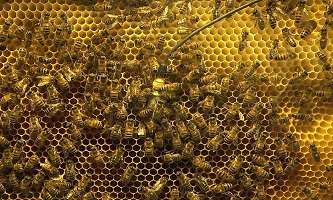Credit: Nottingham Trent University
A honeybee signal – widely thought to be used by bees in the hive to prevent one another from advertising the location of food – could also be a response to being startled or surprised, according to scientists.
Researchers at Nottingham Trent University monitored the vibrations passed between bees in a bid to learn more about the 'stop signal', used by the insects to warn of potential dangers outside the hive.
The researchers argue that the signal, which appears as a 'whooping' sound, occurs in many instances when it is not purely inhibitory. This includes, regularly, when the bees become surprised or startled by involuntary stimuli.
The stop signal is a pulsed vibrational message believed to be directed at bees performing the 'waggle dance' – the method through which they share information about the location of food with other members of the colony.
But the researchers, writing in the journal PLOS One, have found that this signal occurs far too frequently – and at the wrong times of day – for it to only carry an inhibitory function.
They found that the vast majority of such signals occurred at night – when there would be no waggle dances being performed – with a distinct reduction towards midday, when more waggle dances would be occurring.
They also found instances where the signal was produced more than five times per minute, for several successive days, within a small area of the colony.
The scientists were able to show that the signal regularly occurred as a result of accidental collisions between bees within the hive, suggesting that it is an involuntary startle response to a surprise stimulus – such as being landed on by a falling nest mate.
The high occurrences of the signal at night could be due to the increased numbers of bees within the hive at that time, they suggest.
It was also found that the signal peaks when the weather is particularly bad and the bees cannot leave the hive.
It is well known that honeybees use vibrational signals to transfer information to one another across the honeycomb.
The new study, led by researchers in the university's School of Science and Technology, is the first to successfully achieve long-term automated and non-invasive monitoring of honeybee vibrational messages from within the heart of colonies.
It involved placing ultra-sensitive vibrational sensors called accelerometers into the honeycomb in the centre of two hives in the UK and France, continuously recording the vibrational amplitude and frequency over the course of a year. Home-built computer software then enabled the team to scan through a full year of recordings to detect the specific pulse of interest.
A specially-developed observation hive was also used to make video recordings of bees in real-time with the vibrational recordings.
It was found that the same signal could be elicited en masse by gently shaking or knocking the hive.
"We have found that this signal is remarkably common, much more than previously thought," said Dr Martin Bencsik, researcher and physicist at Nottingham Trent University.
He said: " Scientists in the past have explored this signal in artificial circumstances where they ensured that the bees under investigation would be trying to inhibit other bees.
"In our study we have not manipulated our bees in any way, and this has revealed totally unexpected results, yielding new interpretations but also yet more mystery around this brief honeybee vibrational pulse. We believe that in only a small number of instances is it used as an inhibitory signal and therefore have proposed a new name – the 'whooping signal'."
Researcher Michael T. Ramsey added: "Through our work we are expanding the understanding of honeybee communication. This vibrational pulse was originally known as the 'begging signal' as it was believed to be a request for food, then it was thought to be a purely inhibitory 'stop signal'. Now we have taken this another step forward.
"It shows promise that our methods can be used as a sensitive way of monitoring and assessing colony status for these hugely important pollinators."
More information: Michael Ramsey et al. Long-term trends in the honeybee 'whooping signal' revealed by automated detection, PLOS ONE (2017). DOI: 10.1371/journal.pone.0171162
Journal information: PLoS ONE
Provided by Nottingham Trent University























